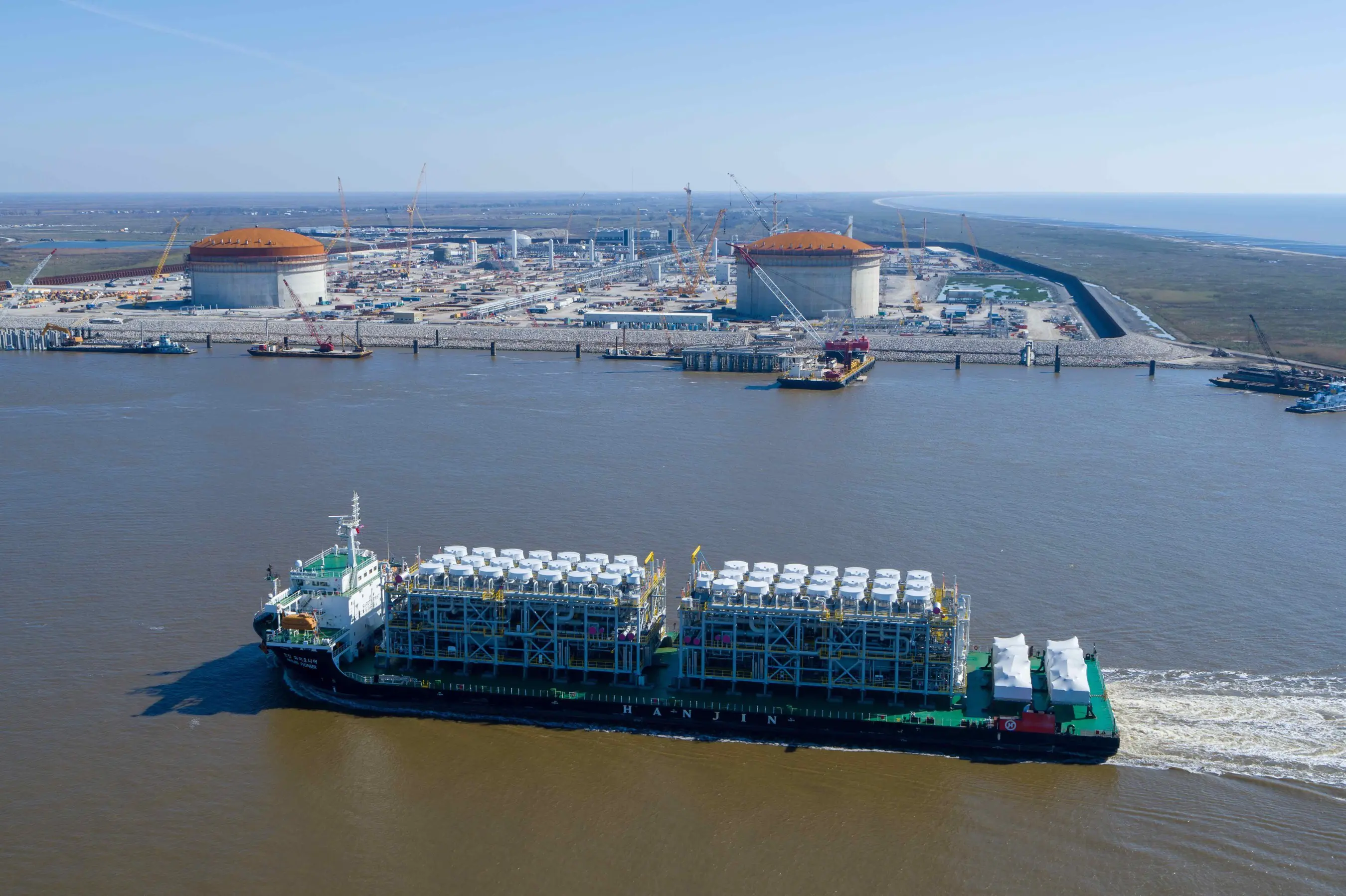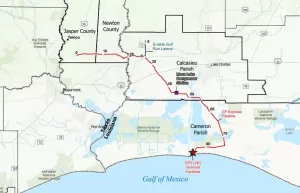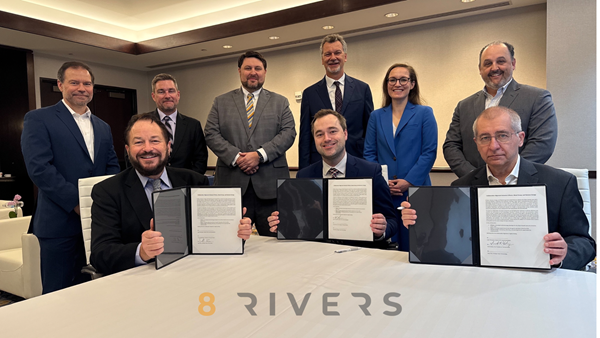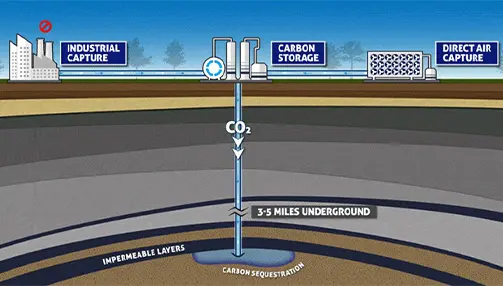126 LNG Trains

Originally published August 9, 2023.
Venture Global LNG (Venture Global) has emerged as one of the fastest growing LNG companies in North America. The company has four main projects. CP2 LNG and Calcasieu Pass LNG will be located next to each other just south of Lake Charles, Louisiana, while Plaquemines LNG and Delta LNG will be located south of New Orleans near the mouth of the Mississippi River.
Calcasieu Pass LNG entered service in 2022 with a nameplate capacity of more than 11 MTPA. When fully completed, the other three projects will each feature a nameplate capacity of more than 20 MTPA. If all goes according to plan, Venture Global LNG will effectively bring more than 70 MTPA of export capacity to life within a five-year time frame. For context, consider that Qatar’s highly anticipated North Field Expansion is 48 MTPA, consisting of two phases — North Field Expansion East at 32 MTPA and North Field Expansion South with 16 MTPA.
To be fair, Qatar has a track record of completing projects on time, whereas Venture Global is a young company that has faced its share of project delays. What’s more, Qatar’s North Field Expansion is backed by high-profile investment groups and the largest energy companies in the world, not to mention the host country’s deep pockets and vast financial muscle.
Qatar has been the LNG story over the last year, and for good reason. However, ignoring Venture Global’s progress would be a big mistake, especially considering the recent events that have bridged the gap between the company’s expectations and what it can realistically achieve in a short amount of time.

FERC Grants Final Environmental Impact Statement For The CP2 LNG And CP Express Pipeline Project
The Federal Energy Regulatory Commission (FERC) has prepared a final environmental impact statement (EIS) for Venture Global’s CP2 LNG and CP Express Pipeline project. The purpose of an LNG-related EIS is to quantify the impacts of constructing and operating the export terminal and associated infrastructure.
FERC’s reports can tip a project’s balance in or out of favor. For example, its EIS on the Alaska LNG project found that construction and operations would result in “temporary to permanent impacts on the environment.” An unfavorable FERC ruling, paired with pushback from environmental groups, can be a death sentence for a prospective LNG project.
FERC is the leading federal agency responsible for preparing LNG EIS reports. However, FERC works closely with the US Department of Transportation’s Pipeline and Hazardous Materials Safety Administration, US Environmental Protection Agency, US Army Corps of Engineers, US Coast Guard, Bureau of Land Management, US Fish and Wildlife Service, National Park Service, US Department of Energy, and National Marine Fisheries Service. These cooperating agencies provide FERC with input to the conclusions and recommendations presented in the EIS. Following issuance of the final EIS, the cooperating agencies release their own decisions, determinations, permits, or authorizations for the project.
The CP2 LNG and CP Express EIS was prepared in compliance with the requirements of National Environmental Policy Act (NEPA), the Council on Environmental Quality regulations for implementing NEPA, and the FERC regulations implementing NEPA. The news comes as a sigh of relief for Venture Global after FERC suspended the environmental review process of CP2 LNG and the CP Express Pipeline in 2022 because the company didn’t provide enough information to its biological assessment of the cumulative impacts of the project.
FERC and its staff found that the project would result in some adverse environmental impacts, but that the impacts would be “less-than-significant.” However, FERC found that climate change impacts were neither significant nor insignificant. Although no LNG project will have zero environmental impact, a project can reduce its carbon footprint by having an on-site combined-cycle power plant or by implementing carbon capture utilization and storage.
The final EIS for CP2 LNG and associated infrastructure addresses the potential environmental effects of the construction and operation of the following project facilities:
- A liquefaction plant consisting of 18 liquefaction blocks and ancillary support facilities. Each block will have a nameplate capacity of about 1.1 MTPA and contain two Baker Hughes electric drive units, each with an associated compressor unit and gearbox in a shared enclosure.
- Six pretreatment systems, each including an amine gas-sweetening unit to remove carbon dioxide and a molecular sieve dehydration system to remove water.
- Four 7-MMscf (200,000-m3) aboveground, full-containment LNG storage tanks with cryogenic pipeline connections to the liquefaction plant and the berthing docks.
- A combined cycle power plant with 10 GE Frame 7E gas turbine generators with a nameplate capacity of 1.47 GW.
- Two marine LNG loading docks and accompanying turning basins and three cryogenic lines for LNG transfer from the storage tanks to the docks.
- Administration, control, maintenance, and warehouse buildings and related parking lots.
- The CP Express Pipeline, which consists of 85.4 miles (137.4 km) of 48-in. (1.2-m) natural gas pipeline.
- Six miles (1.61 km) of 24-in. (610-mm) natural gas lateral pipeline connecting to the CP Express Pipeline in northwest Calcasieu Parish, known as the Enable Gulf Run Lateral.
- One 187,000-hp (139,502-kW) natural gas-fired compressor station, known as the Moss Lake Compressor Station.
- Six metering stations, five at interconnects with existing pipelines and one at the terminus of the CP Express Pipeline.
The project features a nameplate capacity of 20 MTPA and a peak capacity of around 24 MTPA. Construction on the 846-acre (342-ha) site is set to begin later this year, with an estimated in-service date of 2026 or earlier.
In April, CP2 landed a 20-year, 1-MTPA sales and purchase agreement (SPA) with JERA Co. Inc (JERA). JERA had also purchased the inaugural commissioning cargo of Venture Global’s operational facility at Calcasieu Pass. In late June, CP2 landed a 4.25-MTPA, 20-year SPA with Securing Energy for Europe GmbH (SEFE), Germany’s largest LNG supplier. All told, more than half of CP2’s nameplate capacity has been booked, with more than a third of its capacity contracted to German buyers.
Other Projects
Calcasieu Pass
Venture Global Calcasieu Pass LLC developed an LNG export facility along the Calcasieu Ship Channel just south of Lake Charles. The more than 1000-acre (405-ha) site includes a mile of deep-water frontage and 18 0.626-MTPA liquefaction trains configured in nine blocks for a total export capacity of more than 11 MTPA. The facility also includes three pre-treatment trains, each with 50% capacity, two ship loading berths for LNG vessels with a capacity of 6.5 MMscf (185,000 m3), and two 7-MMscf full-containment LNG storage tanks. The facility also features a 720-MW combined cycle gas turbine power plant, including an additional 25-MW gas-fired aeroderivative turbine. A single 42-in. (1.1-m), 24-mile (39-fkm) long lateral pipeline, TransCameron, extends from interconnection points within the vicinity of Grand Cheniere Station in Cameron Parish, Louisiana.
Plaquemines LNG
In March, Venture Global announced a final investment decision (FID) on Phase 2 of its Plaquemines LNG facility. Phase 2 brought in US$7.8 billion in additional financing for a total project budget of US$21 billion. The project is located about 20 miles (32 km) south of New Orleans and will have an export capacity of 20 MTPA. The 630-acre (255-ha) site features 1.3 miles (2 km) of river frontage. Phase 1 is expected to begin producing LNG in 2024, and Phase 2 could begin production as early as 2025.
Delta LNG
Delta LNG is another 20-MTPA project consisting of two, 10-MTPA phases. Located in Plaquemines Parish, Louisiana, the 540-acre (219-ha) site is along the Mississippi River south of New Orleans and close to neighboring Plaquemines LNG. The project will feature 36 0.626-MTPA trains configured in 18 block pairs. The site also features double the LNG storage of Calcasieu Pass LNG with four, 7-MMscf tanks. It will feature three marine loading berths and 1.24 GW of onsite natural gas-fired combined cycle generation. Delta LNG’s in-service date is unknown. However, given the timeline and size of the other projects, it’s likely Delta LNG would come online in 2027 or later.
Venture Global’s Modular Approach
Venture Global is taking a contrarian approach during a time when LNG trains seem to only be getting bigger and bigger. For example, the North Field Expansion East will feature four, 8-MTPA trains, which starkly contrasts Venture Global’s 0.626-MTPA design. The strategy has worked so far, as the train design at Calcasieu Pass LNG supports low construction costs and improves reliability by making it easier to service the facility. Meanwhile, larger trains tend to be built onsite and require massive workforces, leaving more room for error.
Calcasieu Pass featured midscale liquefaction trains and refrigerant compressor skids that were shipped to Louisiana from Baker Hughes’s manufacturing facility in Avenza, Italy. Baker Hughes compressors are being used for Port Arthur LNG Phase I, the Petronas LNG project, and the North Field South project. However, the trains are much larger in size than Venture Global’s projects. Each of Baker Hughes’ main refrigerant compressor trains at North Field South will consist of three Frame 9E DLN Ultra-Low NOx gas turbines and six centrifugal compressors across two LNG trains for a total scope of supply of six gas turbines to drive 12 centrifugal compressors.
The biggest potential downside of Venture Global’s modular approach is that it could lose some of the benefits of scale and result in higher overall project costs. However, that doesn’t seem to be the case when compared to the sizeable expansion project of Qatar’s North Field Expansion. The North Field Expansion East is expected to cost US$30 billion and the North Field Expansion South clocks in at US$20 billion, resulting in US$50 billion of investment for an additional 48 MTPA of nameplate capacity. Meanwhile, Plaquemines LNG will cost US$21 billion for a nameplate capacity of 20 MTPA, which is about the same ratio of roughly 1 MTPA of export capacity per US$1 billion in investment.
One of the reasons why Venture Global can keep a lid on its costs is due to its extremely efficient manufacturing process. Each 0.626-MTPA train is fabricated offsite and delivered fully assembled. Each block consists of two trains and features a cold box that uses single mixed refrigerate technology. The refrigerant compressors are driven by Baker Hughes electric motors. According to Venture Global, controlled factory settings significantly decreases construction labor and increases site safety, execution quality, and on-time delivery.
Venture Global’s strategy is centered around consistency. All four of its projects are in Louisiana and all four feature the same general pipeline buildouts, on-site power systems, train sizes, and storage tanks. In this vein, the company can simply replicate Calcasieu Pass’s success at CP2 LNG, Plaquemines LNG, and Delta LNG.
Different Strokes
The global LNG industry is typically viewed through the lens of export and import capacity and volumes. While these numbers are important, it’s also interesting to look under the hood of projects large and small to see which strategies are the most effective. What we are starting to see, especially in the United States, are stark contrasts in project scope and execution even though many projects feature geographically similar conditions in Texas and Louisiana.
The most important factors for getting an LNG project off the ground are safety, funding, long-term contracts, environmental compliance, operational execution, and engineering, procurement, and construction execution. The advantage of a modular approach is that it reduces the “all or nothing” nature of many LNG megaprojects and makes it easier to construct the facility in stages.
On the surface, Venture Global’s projects are among the largest LNG export terminal undertakings in North America. Peel back the curtain, and you’ll find that the company’s more than 70-MTPA development pipeline doesn’t consist of a few behemoth LNG trains, but rather, is comprised of 126 fabricated mid-size, modular LNG trains. This step-by-step approach may not be ideal for every situation, but it does present some major advantages when it comes to getting an initial project or expansion phase off the ground while also avoiding the reliability nightmares that occur when two or three massive trains are responsible for an entire facility’s output.










